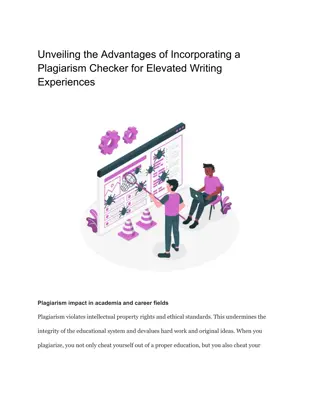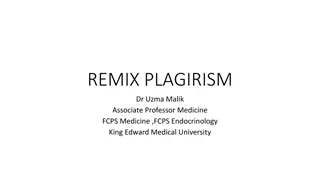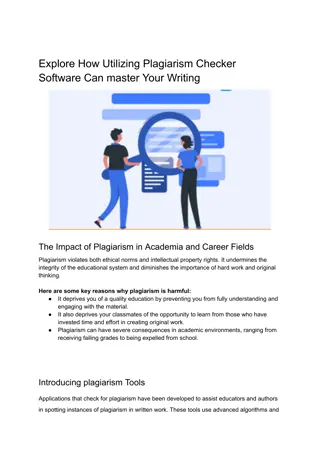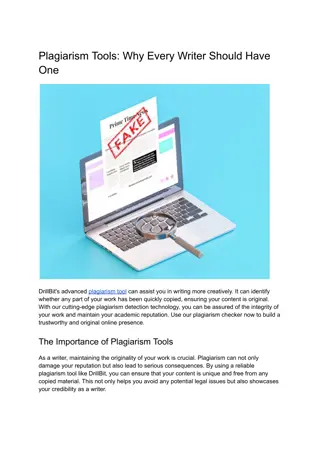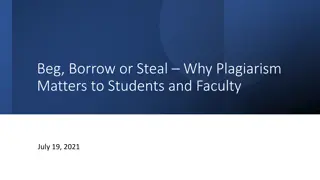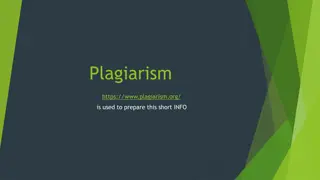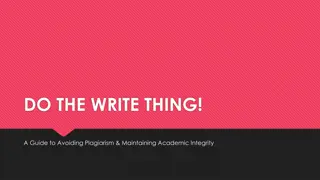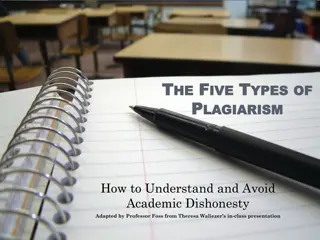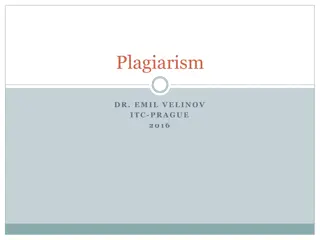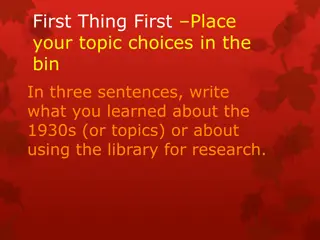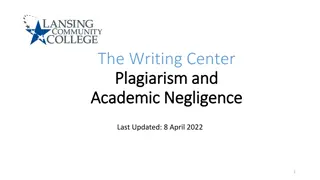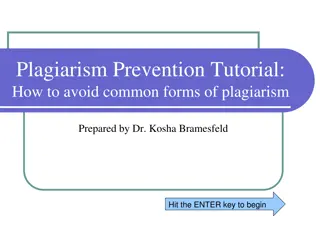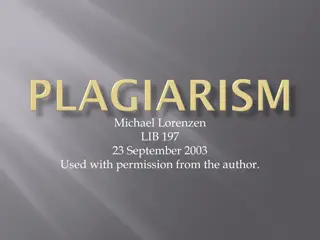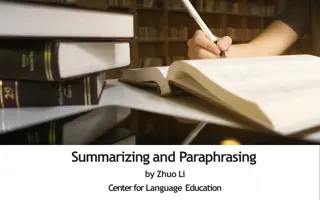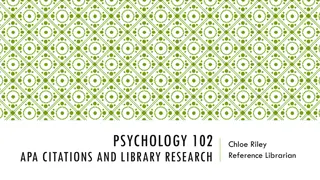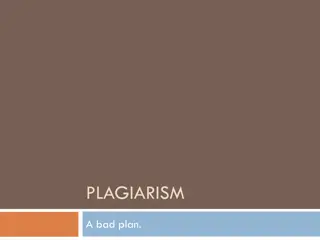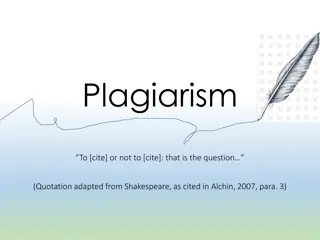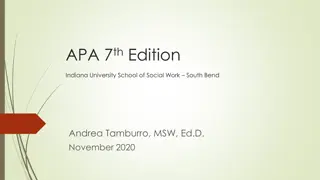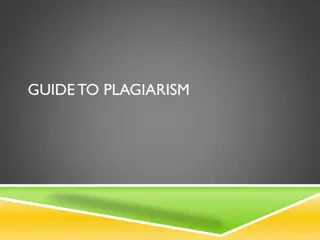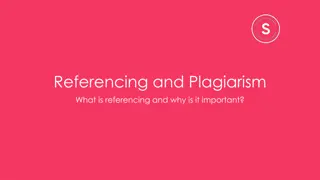Understanding Plagiarism: Types, Examples, and Prevention Techniques
Plagiarism is a serious academic offense that involves using someone else's work without proper acknowledgment. This publication delves into the different forms of plagiarism - intentional and accidental, such as self-plagiarism, and provides examples to help readers understand what constitutes plagiarism. It also offers tips on how to effectively incorporate sources into assignments through direct quotations, paraphrasing, summarizing, and presenting different types of materials while citing sources properly.
Download Presentation

Please find below an Image/Link to download the presentation.
The content on the website is provided AS IS for your information and personal use only. It may not be sold, licensed, or shared on other websites without obtaining consent from the author. Download presentation by click this link. If you encounter any issues during the download, it is possible that the publisher has removed the file from their server.
E N D
Presentation Transcript
Plagiarism Explained A WRITING CENTRE PUBLICATION Created by Sophia Kalliopi Mathioudaki Maria Tenizi Writing Centre Associates (Spring 2020)
Plagiarism includes but is not limited to: (1) using an author s ideas without appropriately crediting the author (2) paraphrasing text from an author s work without appropriately crediting the author (3) duplicating portions of text from an author s work without indicating with either quotation marks or block quote format that the relevant language is directly quoted Plagiarism Defined (See UCLA Law Review, Plagiarism Policy)
Intentional: deliberately committing plagiarism Accidental: unintentionally committing plagiarism Types of Plagiarism Self-plagiarism: when using material you have already submitted or published and present it as new
Presenting ideas from others without citing the original source Building on the ideas of others without citing the original source Using a source too closely when paraphrasing or summarizing Improperly or imprecisely citing a source Translating material without citing the source Instances of Plagiarism
Ways to incorporate sources in your assignments 1. Direct Quotation 2. Paraphrasing 3. Summarizing 4. Presenting other type of material (figures/charts, tables, videos/photos, online material etc.)
Direct Quotation An exact duplication of the author s words in the original source. Source: The Blair Handbook 2007, (pg. 306)
when the original wording is engaging for the reader and you feel you could not match this When to use Direct Quotations? if the quote is particularly well-known where the exact words of an authority would lend support to your own ideas when you want to give the author s exact position Source: The University of Adelaide 2014, (pg. 2)
Paraphrasing A restatement of the author s exact words in order to simplify or clarify an original idea. Source: The University of Adelaide 2014, (pg. 2) Picture
to demonstrate your understanding of the ideas of the author to assist your readers by explaining difficult concepts or terminology when the original ideas are impressive but the original wording is less so when you want to change the emphasis of the ideas to better match your own context to avoid overuse of direct quotes and the consequent risk of losing your own 'voice Why Paraphrase? Source: The University of Adelaide, 2014 (pg. 1)
Summarizing A brief condensation or distillation of the main point of the original source. Source: The Blair Handbook 2007, (pg. 307)
When to Summarize? When you want to establish background or offer an overview of a topic When you want to describe knowledge (from several sources) about a topic When you want to determine the main ideas of a single source Source: George Mason University
In order to avoid plagiarism: 1. Prepare your material prior to composing your assignment Read : , (Source: Library, University of Cyprus) Techniques to avoid Plagiarism 2. Present your sources in In-text citation Footnotes Bibliography Quotation marks
In-text citation An in-text citation is a reference made within the body of text of an academic essay.
Examples of In-text citations According to Thomas (1974), Some bacteria are only harmful to us if they make exotoxins (p. 76) Provided one has certain basic ingredients, the Web offers potential worldwide publication to individuals (Clark 77) Source: The Blair Handbook 2007, (pgs. 424, 380) NOTE: Different reference styles are followed by different universities or faculties Use citation management software to record your sources
RefWorks (available to all UCY members through the Library) Mendeley EasyBib.com EndNote (paid subscription) Zotero ReadCube Papers Sciwheel JabRef Citation management Software
Footnote Footnotes are used to provide additional information that cannot be worked into the main text. Amongst others, footnotes could include citations of a reference work in support of the text. Source: The Blair Handbook 2007, (pg. 427)
Examples of footnotes TEXT WITH SUPERSCRIPT The standard ingredients for guacamole include avocados, lemon juice, onion, tomatoes, coriander, salt, and pepper.1 The standard ingredients for guacamole include avocados, lemon juice, onion, tomatoes, coriander, salt, and pepper. Hurtado s poem, however, gives this traditional dish a whole new twist (lines 10-17). FOOTNOTE 1 For variations, see Beard 314, Egerton 197, Eckhardt 92, and Kafka 29. Beard s version, which includes olives and green peppers, is the most unusual. Source: The Blair Handbook 2007, (pg. 384)
Bibliography A list of the sources referred to in an academic paper, typically enlisted at the end of the paper. When using the APA Reference Style, it is labeled as References, and, when following the MLA Reference Style, it is labeled as Works Cited.
Quotation marks Punctuation marks, single ( ) or double ( ), used to enclose brief quotations (from one word to four typed lines). Do not forget to appropriately document the source of the quoted passage. 2.12. Quotations - The Writer's Guide to the Galaxy
Plagiarism Detection Tools 1) Dupli Checker 2) Copyleaks 3) PaperRater 4) Plagiarisma 5) Plagiarism Checker 6) Plagium 7) PlagScan 8) PlagTracker 9) Quetext 10)Viper For more information on pros and cons of each tool please visit: https://elearningindustry.com/top-10-free-plagiarism-detection-tools-for-teachers
References Fulwiler, T., & Hayakawa, A. R. (2007). The blair handbook (5th ed.). New Jersey, USA: Pearson Prentice Hall. George Mason University. When to summarize, paraphrase, and quote. Retrieved from https://writingcenter.gmu.edu/guides/when-to- summarize-paraphrase-and-quote The University of Adelaide. (2014). To paraphrase or to quote? Retrieved from https://www.adelaide.edu.au/writingcentre/sites/default/files/docs /learningguide-toparaphraseorquote.pdf . : . Retrieved from http://library.ucy.ac.cy


